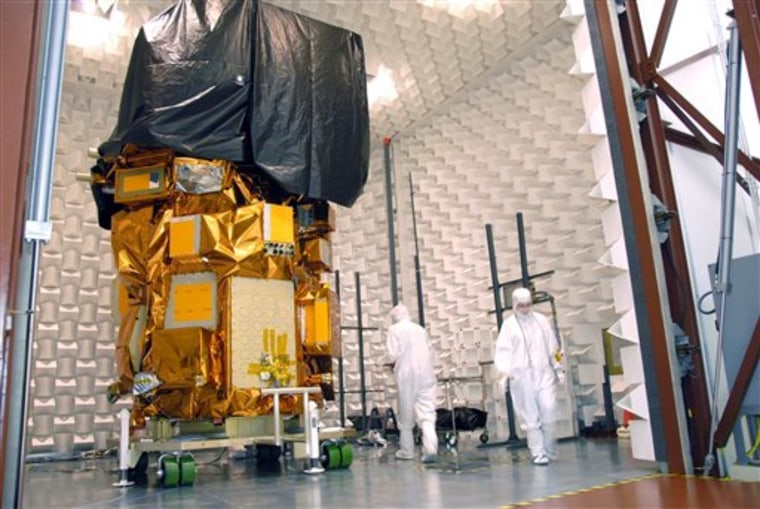A fleet of picture-snapping NASA satellites that for 40 years has documented forest fires, tsunamis and everyday changes in the Earth's geography will soon get a new member.
With Landsat 8 set for a February launch, nearly 140 scientists and engineers from more than 25 countries are scheduled to gather in South Dakota next week to discuss how to best download, process and distribute the millions of data-rich images used in agriculture, education, business and government.
Since 1972, Landsat satellites have been continuously snapping pictures across the globe as part of a 40-year mission to document the planet.
But with Landsat 7 aging and its older sibling Landsat 5 failing, a new orbiter is needed to continue the long-term data record, said Jenn Sabers, remote sensing branch chief at the U.S. Geological Survey Center for Earth Resources Observations and Science.
"One of the things we want to do is preserve that legacy by ensuring that we collect consistent data with the prior missions," Sabers said. "Although we have that consistency, we also want to make improvements."
The USGS Center for EROS, located in the middle of farmland north of Sioux Falls, is the main federal repository for satellite images. Officials wanted to locate the center in the middle of the U.S. and they chose South Dakota in 1970 over several other states, partly due to persistent campaigning by the late Sen. Karl Mundt.
Members of the Landsat Technical Working Group will gather at the center next week to discuss how to best use the data-packed photos from the new orbiter, which will be known as Landsat 8 once it reaches space. The team, which provides scientific and technical input to the U.S. Geological Survey and NASA, will plan how to establish reception, processing and distribution capabilities from the new satellite.
Landsat satellites help document calamities, such as forest fires and hurricanes, as well as map the world's mangrove forests and track ice in the Antarctic. The images differ from programs such as Google Inc.'s Google Earth, as you can't see individual homes, but are able to see larger things, such as highways, NASA says.
Sabers said Landsat 8 will take pictures at a scale and resolution consistent with previous Landsats, with much improved accuracy and data quality. It will also work harder, capturing at least 400 scenes a day instead of 250, and record additional information to detect clouds and mapping of surface water. Another new feature will be off-nadir pointing capability, which can greatly assist the gathering of data during a disaster, she said.
"Before where the satellite would see exactly below it in the track, we can actually point the collection as well," Sabers said. "So we can get something next to where we would normally be collecting."
EROS is part of an international charter that allows the U.S. to get access to other country's satellite data during a disaster and provide it to other countries when calamity strikes there.
Engineers have worked through many anomalies to keep the grizzled veterans taking snapshots. NASA launched the first Landsat satellite in 1972, and the orbiters have been sending images back to EROS ever since. Landsat 7 was launched in 1999, and Landsat 5 dates back to 1984.
Landsat 7 continues to document the globe despite a faulty scan line corrector that leaves zigzag gaps in some of the images. And Landsat 5 is still going more than 28 years after its launch, but it began showing signs of impending failure in November and USGS halted the downloading of images.
Sabers said engineers resurrected an older sensor on Landsat 5, and it's again sending data, but EROS is just archiving the data it can't currently process.
Landsat 6 never reached orbit after its 1993 launch because of a ruptured manifold.
The newest orbiter will hitch a ride on an Atlas 5 rocket, currently scheduled for a Feb. 11 liftoff from Vandenberg Air Force Base in San Luis Obispo, Calif., said Rani Gran, a NASA spokeswoman based at the Goddard Space Flight Center in Maryland.
Landsat 8, which is about the size of a compact SUV with a 30-foot-long deployable sheet of solar panels, is being built with a 5-year design lifespan but will be stocked with at least a 10-year supply of fuel.
NASA is in charge of building and launching the satellite before turning over operation to the USGS, though NASA also uses Landsat data for science, Gran said.
Long-term plans call for another orbiter to be launched before the end of Landsat 8's run.
"Hopefully we'll be able to continue with the next mission after that that will extend it even further," Sabers said.
